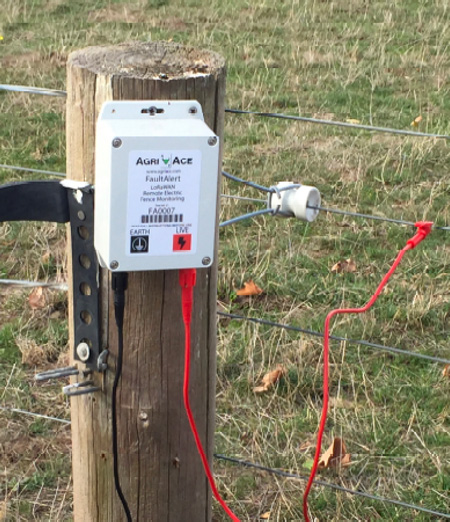Electric fence monitor
Download a printable version of this page: Electric fence monitor ![]() [PDF File - 1.4 MB]
[PDF File - 1.4 MB]
A device that remotely monitors and reports the voltage of your electric fence.
How does it work?
This small portable system clips on to your electric fence to provide alerts when there is a fault that needs fixing. It connects via a network such as LoRaWAN and sends voltage readings to a dashboard.
The dashboard displays voltage levels and can be customised to send alerts via SMS or email when there are changes in voltage.
Some systems come with a solar panel to keep the battery charged.
 Why do I need it?
Why do I need it?
- The sensor can save you time. It provides real-time information about the status of your electric fence, reducing the need to physically inspect the fence unless there is a fault. This is especially useful for remote paddocks.
- The system provides peace-of-mind that the fence is working when you’re not there.
- Units are semi-portable, allowing the user to move them around the farm to monitor specific sections of an electric fence system.
- History functions on the associated dashboard will show if a unit is recharging
How is it used?
Farmers in a South West Victorian demonstration are using Electric Fence sensors to …
- Connect electric fence sensors on out-paddocks, saving daily visits.
Other benefits from Electric Fence sensors include …
- Using multiple units to help narrow down the location of faults.
- Alerting producers to pest animal entry. By placing a hot wire at the bottom of a fence line it is possible to receive a notification when a pest animal has contacted the wire.
Things to consider
- Not all systems offer both SMS and Email alert options. SMS alerts may also include small, additional on-going charges.
- The sensor requires access to a LoRaWAN network.
- Solar and battery options are available, depending on the system.
- Avoid placement of sensors and wires where they can be accessed by stock.
- Some fence sensors are set up on the energizer unit to monitor amps rather than directly monitoring the fence voltage. These systems generally send alerts via a WiFi network.
Tech requirements
- Devices require a network to send information to the dashboard.
- The maximum fence voltage may be limited for some fence sensors, however most standard agricultural setups should be within range.
Where do I find out more?
- https://www.farmo.com.au/collections/sensors/products/electric-fence
- https://www.agriace.com/
- https://agriculture.vic.gov.au/on-farm-demos
About the project
Smart Farm Sensor Demonstrations: This project is supported by Glenelg Hopkins CMA, through funding from the Australian Government’s National Landcare Program, Agriculture Victoria, Grasslands Society of Southern Australia, Southern Farming Systems and Southern Grampians Shire Council. The project runs from 2019-21 to test and demonstrate a range of devices on farms in the south west region, including stock water and tank monitors, soil moisture probes, electric fence sensors and weather stations. The sensors provide real-time feedback to producers enabling them to make more informed decisions and better use of labour, time and capital.